Samsung Galaxy S7 edge versus Galaxy Note 5
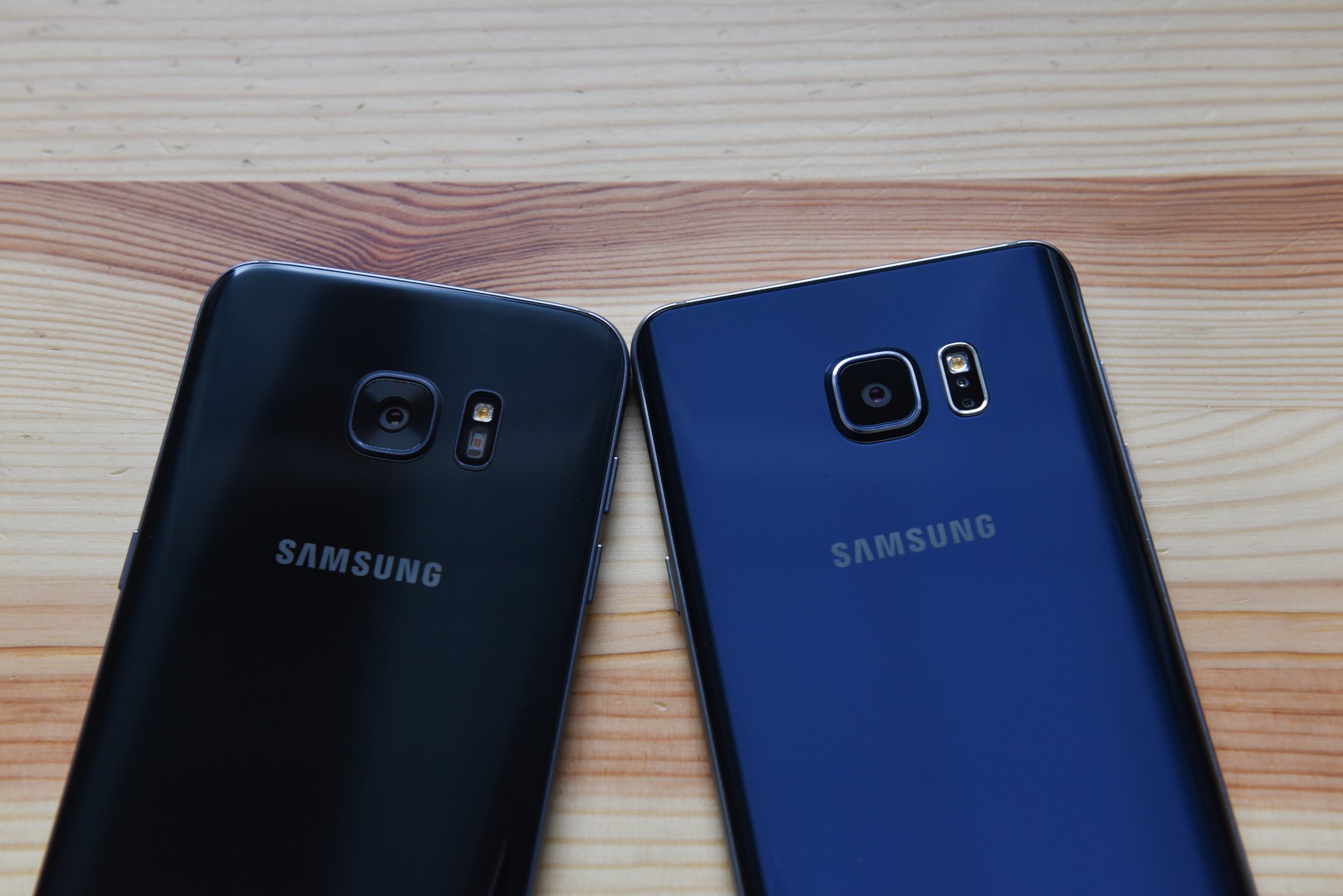
At first blush, it would be difficult to recommend the Galaxy Note 5 of 2015 over Samsung's brand new 2016 flagship, the Galaxy S7 edge.
But when you dig deeper, there are some ways the Note 5 stands out, and not just in the obvious stylus-infused narrative we return to each fall when Samsung releases yet another Note.
Though much of the attention right now is on the Galaxy S7 edge, the Note 5 offers a few clear advantages, and still comes off as an incredibly powerful and capable smartphone. Curious to learn how? Read on.
Hardware and specs
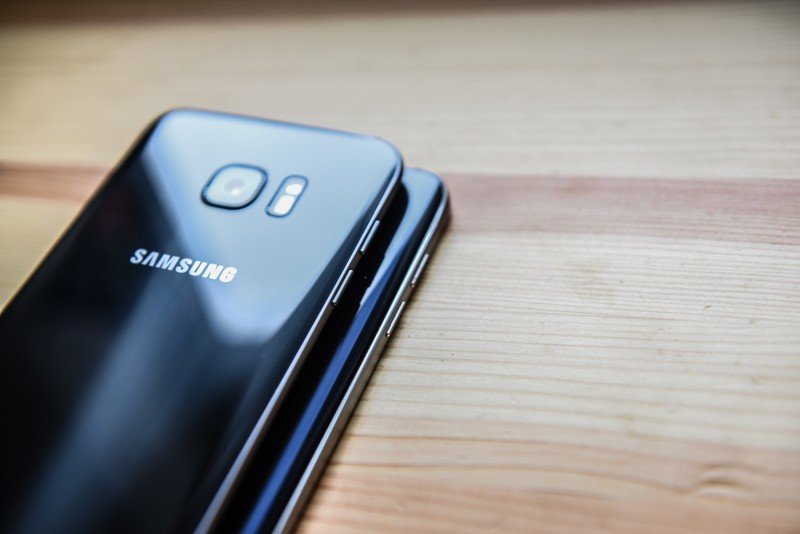
The Note 5 was Samsung's first device with a curved glass back, making it much easier for people to hold given its 5.7-inch display size. Not only did that curve make it easier to hold, it added a beautiful infinity pool quality to the Note's rear, distinguishing it from the Galaxy S6 edge+, which was announced at the same time. To many, the Note 5 marked a maturity in Samsung's design story, a striking turn from just a year earlier when the Galaxy S5 was still being criticized for its plastic chassis.
With the Galaxy S7, Samsung combines the best of the Note 5 and the Galaxy S6 edge+ into one device, offering the glass-and-metal structure that debuted with the GS6 with accents like a curved back and front. To that end, the Galaxy S7 edge is clearly in the same family as the Note 5, but its extremely narrow side bezel makes it slightly more difficult to pick up off a table, or grip solidly in the hand. Those are really the only criticisms of a smartphone that has what appears to be the entire tech industry in heat.
The question is, S Pen or Edge Display?
Many people deciding between the Note 5 and S7 edge will have to contend with each device's biggest features: the S Pen and curved display, respectively. That's because they are extremely similar in most other respects: both have the same QHD resolution display, though the S7 edge's is slightly brighter and, at 5.5-inches to the Note 5's 5.7, a tiny bit sharper. Internally, the Note 5's Exynos 7420 processor and 4GB of RAM stand up well to the GS7 edge's Snapdragon 820 (or, in Canada, Europe and the rest of the world, Exynos 8890) and 4GB of RAM. In real-world testing, these two phones are among the fastest in the industry, and it won't be for some time that the GS7 edge's 20-30 percent (theoretical) extra horsepower will become evident.
Back to those distinguishing features. Many people love the Note series' S Pen, utilizing it for note-taking, drawing, and in compatible apps. As we'll go over in the next section, Samsung made a number of improvements to Air Command, the Note's stylus command center, in the Note 5's Android 5.1.1 software. By taking the S Pen out of its holster, Air Command brings up a bevy of possible actions, including an overhauled S Note app that works with the lower-latency stylus itself to create what is easily the best handwriting experience on a smartphone today. Personally, I don't use the S Pen enough to recommend it over a similar device without it, but the question here is whether it is more useful than the Galaxy S7 edge's curved display, and that is more difficult to answer.
Be an expert in 5 minutes
Get the latest news from Android Central, your trusted companion in the world of Android
With the Galaxy S7 edge Samsung made better use of the Edge Display, that tiny lip that, when swiped in from the right side of the screen, brings up a number of shortcuts and easily-digestible bits of information such as favorite apps and contacts, sports scores and basic utilities. Here's the thing, though: Samsung could have easily added the edge display functionality to the regular Galaxy S7, or any of its former Galaxy products, without sacrificing usability. Sure, it feels better to swipe in on a curved display, but that doesn't preclude it from working on flat glass.
The curved edges look amazing, but aren't exactly useful.
So the question is whether the Edge Display has any other value, which leads us to talk about its aesthetic qualities. The curved edges look amazing, period. I think it's OK to care about how a piece of technology looks, especially one that you carry with you every day, and doubly so when those qualities don't detract from using the product. The Galaxy S7 edge is probably the best-looking phone Samsung has ever released. It also has a slightly more matte look to it when compared to the Note 5; the aluminum is slightly darker and less reflective, and the curved edges eliminate the pronounced bezel that we see on the Note 5.
Moreover, the S7 edge (and its non-edge counterpart) heralds the return of the microSD slot that was removed in the S6 line (and absent from the Note 5), and waterproofing from the S5.
| Category | Galaxy Note 5 | Galaxy S7 edge |
|---|---|---|
| Operating System | Android 5.1.1 LollipopMarshmallow update pending | Android 6.0.1 Marshmallow |
| Display | 5.7-inch QHD (2560x1440, 518 ppi) Super AMOLEDGorilla Glass 4 | 5.5-inch QHD (2560x1440, 534 ppi) Super AMOLEDGorilla Glass 4 |
| Processor | Exynos 7420 octa-core (2.1GHz quad + 1.5GHz quad) | Snapdragon 820 quad-core or Exyos 8890 octa-core |
| Storage | 32 or 64GBNon-expandable | 32GBmicroSD expandable |
| RAM | 4GB (LPDDR4) | 4GB (LPDDR4) |
| Rear Camera | 16MP, f/1.9, OIS, phase detection auto focus4K video, 120fps slow motion | 12MP, f/1.7, OIS, dual-focus pixels4K video, 240fps slow motion |
| Front Camera | 5MP, f/1.9 | 5MP, f/1.7 |
| Connectivity | 802.11ac Wi-Fi, 2.4/5GHz, MIMO (2x2)Bluetooth v4.2 LE, ANT+NFC, Location (GPS, Glonass, Beidou) | 802.11ac Wi-Fi, 2.4/5GHz, MU-MIMOBluetooth v4.2 LE, ANT+NFC, Location (GPS, Glonass, Beidou) |
| Charging | Micro-USB 2.0, Adaptive Fast ChargingQi wireless, Powermat wireless, fast wireless charging | Micro-USB 2.0, Adaptive Fast ChargingQi wireless, Powermat wireless, fast wireless charging |
| Battery | 3000 mAhNon-removable | 3600 mAhNon-removable |
| Waterproofing | No | IP68 waterproofing |
| Dimensions | 153.2 x 76.1 x 7.6mm | 150.9 x 72.6 x 7.7 mm |
| Weight | 171g | 157g |
Software and performance
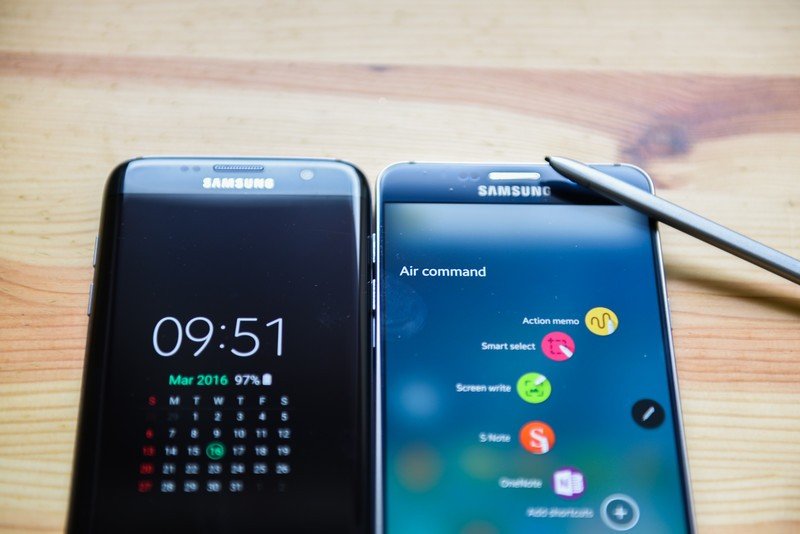
Unlike some other comparisons we've done in the past, extracting differences in the software of two Samsung devices is relatively difficult.
Unless you're on Verizon (at the time of writing), the Note 5 still runs Android 5.1.1 Lollipop in most parts of the world, including my Canadian unit. On the other hand, the Galaxy S7 edge ships with Android 6.0.1, and even has the next-to-most recent Android security patch on most carriers.
The differences in the two pieces of software is subtle, especially when removing the device-specific features like Air Command and Edge Screen. Samsung has softened some of the blue and green-heavy color palettes that shipped on its Lollipop devices, moving to a more mature blue and grey. These changes can mainly be seen in the notification shade and some of the menus.
Of course, by running Android 6.0.1, the Galaxy S7 edge benefits from some of Google's native improvements, such as Doze, runtime app permissions, and a variety of performance improvements. These will all come to the Note 5 in due time, along with these color updates, but some users may have to wait longer than others.
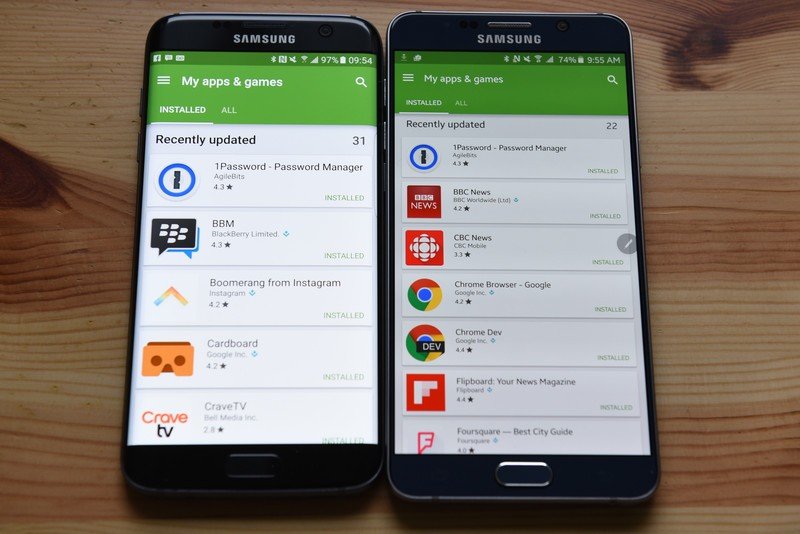
The one other thing to note when it comes to the look of the software is that the Note 5 ships with a higher DPI (or display density) preset than the Galaxy S7 edge, which allows it to fit more interface elements on the screen at once. The benefits are clear when scrolling through long lists and web pages, but it's relatively easy to achieve the same result on the GS7 edge with a handy app — and even if you leave it at its default, you won't be missing much.
Finally, the battery on the GS7 edge is a capacious 3600 mAh compared to the Note 5's 3000. In real-world use, that should represent a couple more hours of uptime per day, but the truth is that without Doze and App Standby, it's difficult to tell how much of the GS7 edge's battery advantage is due to the bigger battery cell or the newer software. We know the Note 5 doesn't have much of an issue getting through a day now even on Lollipop, and that can only improve with the latest software tweaks from Samsung.
Camera quality

Here's where things get interesting. The Note 5 benefited from a more comprehensive Pro Mode when it shipped last year with the same 16MP camera sensor and lens combo as the GS6. It quickly became my favorite Android phone to shoot with, given the big, vibrant viewfinder, incredibly fast autofocus, true depth of field from the f/1.9 lens, and excellent optical image stabilization which made up for some of the sensor's deficiencies in low light. But it also had some issues: there was some major over-sharpening happening on daylight photos, and the 16:9 sensor crop was not great for portraits and other closeups.
The Galaxy S7 edge attempts to overcome both of those issues. Not only does it share the same great Pro Mode (along with an excellent Auto mode that takes great shots in nearly every environment), but Samsung dropped the megapixel count from 16 to 12, increasing the size of the sensor's individual pixels in the process. It also reframed the sensor's aspect ratio to 4:3, bringing it more in line with the rest of the industry. And alongside the larger pixels, which let in more light, the new f/1.7 lens is faster and wider, improving both low light and depth of field.

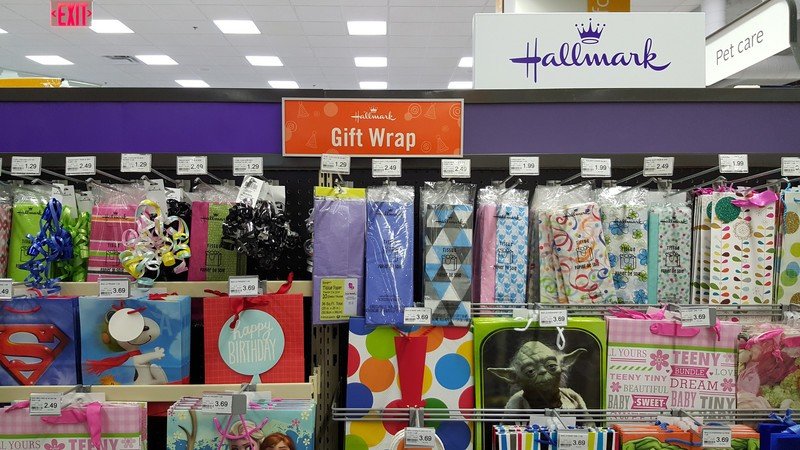
Galaxy S7 edge (left) / Galaxy Note 5 (right); click images to view larger
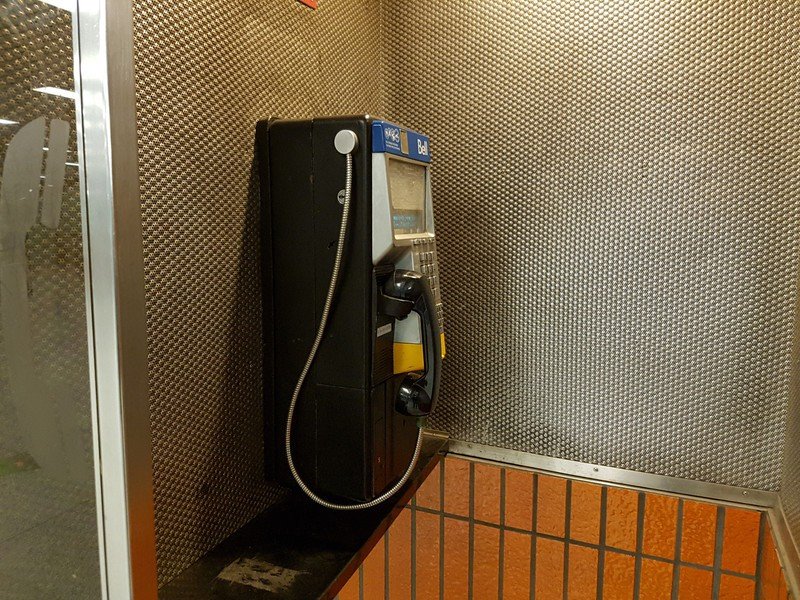
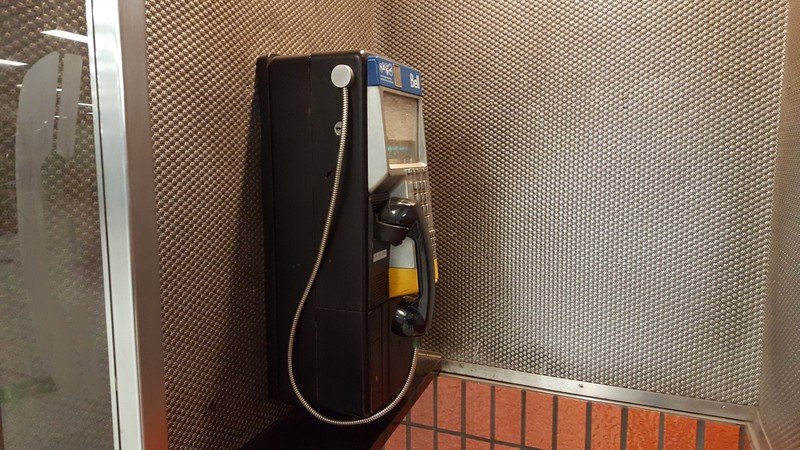



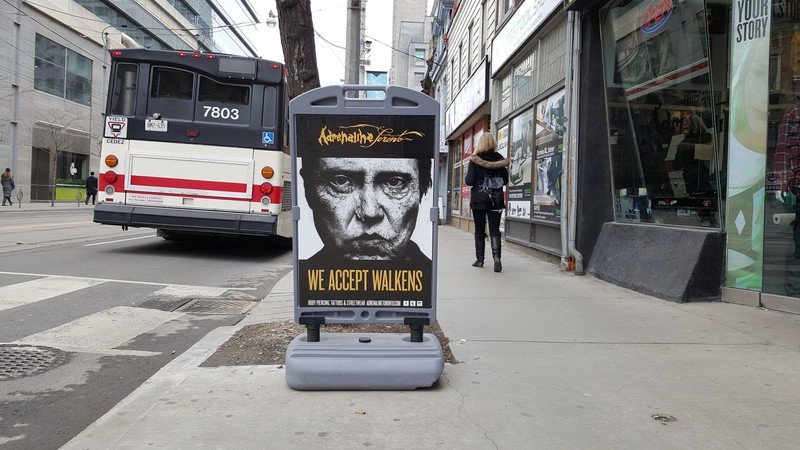
Unfortunately, it's not immediately clear which is the better camera in every situation. While low-light photography is indeed improved over the Note 5, the Galaxy S7 edge doesn't always come out ahead in daylight photos. What could be as easy as a minor software update may also be a more complex issue with the new 12MP sensor, which captures lower-resolution photos.
Both cameras are among the best in the industry, but overall I'd have to give the edge to the, um, edge.
Bottom line

These are both great phones, and the choice isn't as clear as when I started researching this piece. While I love the GS7 edge's matte finish and curved display, I often feel more comfortable using the Note 5, with its easy-to-grip sides and larger display. I also think the S Pen offers more long-term usability, especially for avid note-takers, than the Edge Screen, which in software has yet to meet the potential of the beautiful hardware.
Of course, I have to say the Galaxy S7 edge is the better phone, because in many ways it is: it has a faster processor, a slightly brighter display, a camera that performs better in low light, waterproofing, the return of the microSD slot, and, right now at least, the latest version of Android. When the Note 5 receives Marshmallow, however, which for non-Verizon users should be any day now, the contest may be even closer than it is today.
In any case, you can't go wrong with either phone — find the one that meets your needs in terms of features and price, and you'll be happy here.
Daniel Bader was a former Android Central Editor-in-Chief and Executive Editor for iMore and Windows Central.

